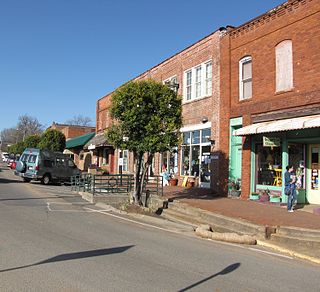
Pittsboro is a town in Chatham County, North Carolina, United States. The population was 3,743 at the 2010 census and 4,537 at the 2020 census. It is the county seat of Chatham County.
Green Level is an unincorporated community in southwestern Wake County, North Carolina, United States. It was founded c. 1800 and is one of the best preserved crossroads communities in the county. Although historically connected to the town of Apex, Green Level now lies within the municipal jurisdiction of the town of Cary.
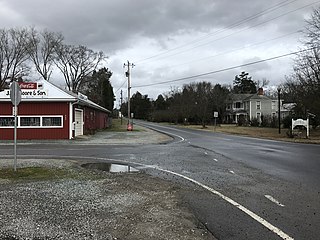
Gulf is an unincorporated community and census-designated place (CDP) in southwestern Chatham County, North Carolina, United States, southeast of the town of Goldston. As of the 2010 census, the Gulf CDP had a population of 144. The community is home to a general store and several historic homes. It received its name from its location at a wide bend in the Deep River.
Alston-DeGraffenried Plantation or Alston-DeGraffenried House is a historic property located in Chatham County, North Carolina, near Pittsboro, North Carolina. It includes a plantation house built through the forced labor of at least 11 enslaved people between about 1810 and 1825, and its surrounding agricultural fields. The property was first listed on the National Register of Historic Places in 1974 and the listed area was increased in 1993. The house and the surrounding land are identified as a national historic district.
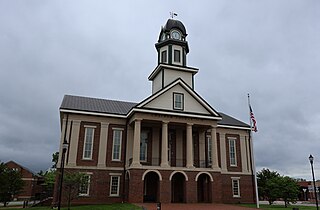
The Chatham County Courthouse is a historic courthouse located at Pittsboro, Chatham County, North Carolina. It sits at the center of town in the middle of a traffic circle. It was built in 1881 for $10,666 and is a two-story rectangular brick structure in the Late Victorian style. It features a two-story classical portico crowned with a distinctive three-stage cupola. A one-story addition was built in the 1930s by the Works Progress Administration. In 1959, extensive renovations were performed on the building.

Pittsboro Presbyterian Church is a historic Presbyterian church located on N. East Street in Pittsboro, Chatham County, North Carolina. It was built about 1850, and is a one-story brick church. The tower and steeple were replaced in 1875 following a tornado, and again in the 1920s and in 1971.

Halifax Historic District is a national historic district located at Halifax, Halifax County, North Carolina, US that was listed on the National Register of Historic Places in 1970. It includes several buildings that are individually listed on the National Register. Halifax was the site of the signing of the Halifax Resolves on April 12, 1776, a set of resolutions of the North Carolina Provincial Congress which led to the United States Declaration of Independence gaining the support of North Carolina's delegates to the Second Continental Congress in that year.
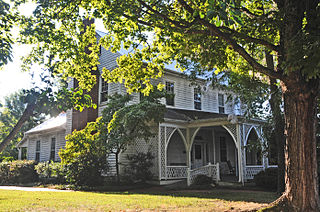
Hall-London House is a historic home located in Pittsboro, Chatham County, North Carolina. It was built in about 1836, is a tall two-story, five bay Federal / Greek Revival style frame dwelling. It features a broad Gothic Revival style front porch. A two-story rear ell was added about 1900.

McClenahan House is a historic home located at Pittsboro, Chatham County, North Carolina. It was built before 1830, and is a one-story, three-bay, frame dwelling on a brick foundation with Greek Revival and Federal style design elements. The house began as a one-room house and is one of only four buildings in Pittsboro that dates from the settlement era.
Moore-Manning House is a historic home located at Pittsboro, Chatham County, North Carolina. It was built in the 1830s, and is a two-story, three-bay, Federal style frame dwelling with a hipped roof. The house was renovated in 1858 and a two-story wing added.

Reid House is a historic home located at Pittsboro, Chatham County, North Carolina. It was built about 1850, and is a 1+1⁄2-story, three-bay, Federal / Greek Revival style double-pile plan frame dwelling. It has a broad gable roof and two interior chimneys. The house was renovated in the 1930s.

Patrick St. Lawrence House, also known as the Yellow House, is a historic home located at Pittsboro, Chatham County, North Carolina. It was built about 1790, and is a two-story, center hall Georgian style architecture frame dwelling with a low gable roof. It was originally built as an inn and overlooked the courthouse square. It is Pittsboro's oldest building. It has been moved three times and is now located on S. Small St.
Mount Vernon Springs Historic District is a national historic district located near Bonlee, Chatham County, North Carolina. The district encompasses 23 contributing buildings, 3 contributing sites, and 7 contributing structures in the rural village of Mount Vernon Springs. The village grew up near a locally famous mineral spring. Notable buildings include the Greek Revival style Female Dormitory of the Baptist Academy (1855), Gothic Revival style Mt. Vernon Springs Presbyterian Church (1885), the John C. Kirkman House, Robert P. Johnson House, and John M. Foust House. Also located in the district are the Mt. Vernon Springs, the Baptist Academy Cemetery, and the Mt. Vernon Springs Presbyterian Church cemetery.
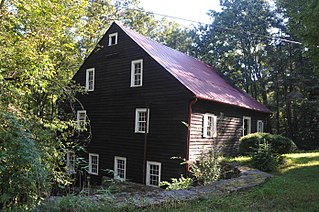
Baldwin's Mill is a historic grist mill and national historic district located near Pittsboro, Chatham County, North Carolina. The district encompasses one contributing building and three contributing structures. The mill was probably built by 1807, is a 1 1/2- to 2+1⁄2-story, heavy timber-framed structure approximately 30 feet by 40 feet. Associated with the mill are the mill dam, and mill and tail races. The property also includes a stretch of roadbed dates to about 1820, a blacksmith's shop site, and two log cabins moved to the property in 1975. The mill ceased operation in the late 1920s. It was restored to working order in 1941.
Tarboro Historic District is a national historic district located near Tarboro, Edgecombe County, North Carolina. The district encompasses 364 contributing buildings in central Tarboro. It includes a variety of industrial, commercial, residential, and institutional buildings dating from the late-18th through early-20th centuries. Located in the district are the separately listed Tarboro Town Common, The Barracks, Redmond-Shackelford House, Pender Museum, Blount-Bridgers House, Coates-Walston House, Calvary Episcopal Church and Churchyard, and the Cotton Press complex. Other notable buildings include the Morris-Powell House, Porter House, U. S. Post Office (1914), Pippen House (1870s), Dancy-Battle-Bass Clark House, Holderness House, Howard Memorial Presbyterian Church (1908-1909), W. H. MacNair House (1913), Henry Cherry-George White House, Jones House (1870-1875), Tarboro Primitive Baptist Church, St. James Methodist Church (1916), Carolina Telephone & Telegraph (1912), Clark's Warehouse #1 and #2, Battle-Porter-Powell House, Gaskil1-Hussey House (1882), Cheshire-Nash House, and Norfleet Court (1858).

The Wilmington Historic District is a national historic district located at Wilmington, New Hanover County, North Carolina. The district encompasses 875 contributing buildings 38 contributing sites, and 3 contributing structures in the historic core and surrounding residential sections of Wilmington. The district developed after Wilmington was laid out in 1737, and includes notable examples of Queen Anne and Bungalow/American Craftsman style architecture. Located in the district are the separately listed City Hall/Thalian Hall and Alton Lennon Federal Building and Courthouse. Other notable buildings include:

Reidsville Historic District is a national historic district located at Reidsville, Rockingham County, North Carolina. It encompasses 324 contributing buildings, 1 contributing site, 11 contributing structures, and 1 contributing object in the central business district and surrounding residential sections of Reidsville. It was developed between about 1865 and 1941, and includes notable examples of Italianate, Queen Anne, American Craftsman, and Classical Revival style architecture. Located in the district are the separately listed Penn House and Gov. David S. Reid House. Other notable buildings include the Oaks-Motley House, Colonel A. J. Boyd House (mid-1870s), Reid Block (1880s), Citizens' Bank Building, William Lindsey and company Tobacco Factory, First Baptist Church, Main Street Methodist Church, Melrose (1909) designed by architect Richard Gambier, R. L. Watt house designed by Willard C. Northup, First Presbyterian Church (1922), St. Thomas Episcopal Church, Grand Theatre, Belvedere Hotel, United States Post Office and Federal Building, and the Municipal Building (1926).
Salisbury Historic District is a national historic district located at Salisbury, Rowan County, North Carolina. The district encompasses 348 contributing buildings and 1 contributing site in the central business district and surrounding residential sections of Salisbury. It includes notable examples of Late Victorian, Colonial Revival, and Bungalow / American Craftsman style architecture. Located in the district are the separately listed Maxwell Chambers House, McNeely-Strachan House, Archibald Henderson Law Office, and the former Rowan County Courthouse. Other notable buildings include the tower of the former First Presbyterian Church (1891-1893), Rowan County Courthouse (1914), Conrad Brem House, Kluttz's Drug Store, Bell Building, Washington Building, Grubb-Wallace Building, Hedrick Block, Empire Hotel, St. Luke's Episcopal Church (1827-1828), Soldiers Memorial A.M.E. Zion Church (1910-1913), U.S. Post Office and Courthouse (1909), City Hall (1926), Salisbury Fire House and City Building (1897).

Gwyn Avenue–Bridge Street Historic District is a national historic district located at Elkin, Surry County, North Carolina. The district encompasses 124 contributing buildings and 1 contributing site in a predominantly residential section of Elkin. They were primarily built between about 1891 and 1955 and include notable examples of Queen Anne, Colonial Revival, and Bungalow / American Craftsman architecture. Notable buildings include the Elkin Presbyterian Church, First Baptist Church, Alexander Martin Smith House (1893–1897) designed by George Franklin Barber, the Gwyn-Chatham-Gwyn House, Richard Gwyn Smith House, and Mason Lillard House.
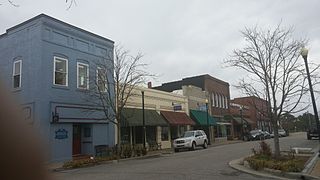
Columbia Historic District is a national historic district located at Columbia, Tyrrell County, North Carolina. It encompasses 119 contributing buildings, 1 contributing structure, and 1 contributing object in the central business district and surrounding residential sections of Columbia. The district developed between about 1880 and 1944 and includes examples of a variety of popular architecture styles. Located in the district is the separately listed Tyrrell County Courthouse. Other notable buildings include Snell's Inn, Columbia Garage, Columbia Christian Church, McClees-Coffield House, Combs-Hussey House, Frederick L. W. Cohoon House, Columbia Baptist Church (1905), W. J. White Building (1931-1932), Columbian Theatre, Wesley United Methodist Church (1912), St. Andrews Episcopal Church (1909), Tyrrell County Jail, Merchants and Farmers Bank / East Carolina Bank, Tyrrell County Bank, and Columbia Theatre.


















